Color me colors--
Now look—please don’t laugh or snicker! I’m about to make a painful confession, because I’m doing it in the interest of research into modern pop psychology and to possibly save you from blowing $22.50.
I just paid that amount to get a download “analysis” of WHO I AM. I’m a sucker for these things, ever since my father-in-law—normally a stable man (he was a wheat farmer in eastern Colorado, following a failed career as a chiropractor in Los Angeles . . . well, now that I think about it, maybe he wasn’t that stable, after all)—introduced me to a system that, by observing the shape of people’s faces, you could figure out “WHO THEY ARE.” He assured me in 1960 this was no mere parlor game--it was serious stuff! He had invested in a book that probably cost the equivalent of today’s $22.50.
As I recall the idea, there are four basic types of facial structure: round, oval, triangular and square. The most sensitive (and, as I recall, the most preferred by the authors) types were people with triangular-shaped faces—these people were intelligent, creative, and extrovert (presumably the best personality type to be), while the most sensible types were the square-faced persons. The book contained tear-out pages printed with charts that you could use to do your analyses, referring to the chapters arranged around these four types, listing the various characteristics, including their good, bad, and best points. A few minutes scanning the “positive” and “negative” characteristics of each facial type and . . . voila!
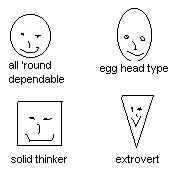 Today, zealots have refined this analysis, extending facial shapes considerably, presumably because of their tireless "scientific research;" you can check it out quickly at this LINK.
Today, zealots have refined this analysis, extending facial shapes considerably, presumably because of their tireless "scientific research;" you can check it out quickly at this LINK.
At about the same time the more “serious” analytical tool was revived: Handwriting Analysis (graphology).
This tool was developed in earnest during the same era (18th and 19th centuries) as Phrenology—feeling the lumps on skulls to tell what kind of a person owned them—and became especially popular about the same time as Freud’s method of finding out WHO WE ARE, having to do with the elusive ego, the id, and the super ego. 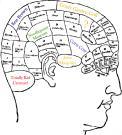
In the 19th century, Freud and his followers, as we know, established the European School of theories in an attempt to establish a new "science" of the mind. How successful this "science" has been is open to debate; my own bias is reflected in this essay.
While Phrenology has generally run its course and is seen today to be fraudulent "science" (except for a few on the fringes today), Graphology was raised from obscurity and is still a tool that fascinates a wide range of people interested in finding out WHO THEY ARE. Handwriting (which advocates confidently call "brainwriting") is still a popular parlor pastime and to a considerable extent, after being very widely used in the 1960s by corporate employers to make hire and fire decisions, is still practiced, albeit more sparingly, by some human resources people; it is also occasionally used in the investigative phases of law enforcement.
Not slow off the mark was the American School—stimulated, curiously, by the Soviet search in the 1920s and 1930s for the predictable, productive, ideal “New Soviet Man” (Pavlov’s experiments with bells and salivating dogs comes to mind). The American credited with developing the “self-realization/actualization hierarchy”—a brave attempt to pull together the loose ends of the European and Soviet theories of an evolving new industry—was Abraham Maslow.
Americans love to simplify wherever possible, and Maslow managed to do this by tying the loose ends of the various theories floating about at the time into a neat “package.” He then developed an easy-to-understand set of rules by which mankind can be defined and classified. His efforts were represented by his “pyramid” or “triangle” consisting of the five levels ("hierarchies") of human "needs." It’s so simple that now almost anyone can become a practitioner of the mind with minimal effort. Indeed, psychology departments in the academy were given new life and began to expand almost overnight; eager students--many themselves in need of help--were introduced to monkeys' need for love (this was the domain of Professor Harlow, Maslow's friend and mentor) and rats were rewarded when they successfully found their way out of mazes (conversely, the poor things were jolted by electricity when they didn't). In short, advanced phases of the mind industry were born and their practitioners were convinced that they now possessed the power to help people find meaning in their irresolute lives.
From monkeys and rats, the professors made a quantum leap to the proposition that people too could be similarly classified into little compartments; then, if suffering from lack of esteem or other undesirable social traits, they could be treated by dealing with their lack of fulfillment of one or more of the five “needs” (starting from the top of the triangle: "actualization," "esteem," "love-belonging," "safety," and "physiological"). Of course, in addition to the wonderfully simple triangle, you'll need Maslow's textbooks that present in a handy format the “symptoms and treatments” that, if diligently applied, will lead yourself and others to Happy Land.
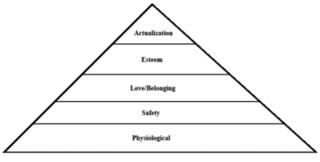 ENTER THE PARLOR COLORS ASSESSMENT SCHEME: I came to know the newly packaged and updated parlor game online the other day for $22.50. It's called “Color Assessment”--a variation of its predecessors. After answering a mere 24 questions, this system will tell you--as long as you answer the questions honestly (as the authors admonish you before you begin)-- WHO YOU (REALLY) ARE. As in the other "mind games," that's the first step to either avoiding mental anomalies or to extricating oneself from them.
ENTER THE PARLOR COLORS ASSESSMENT SCHEME: I came to know the newly packaged and updated parlor game online the other day for $22.50. It's called “Color Assessment”--a variation of its predecessors. After answering a mere 24 questions, this system will tell you--as long as you answer the questions honestly (as the authors admonish you before you begin)-- WHO YOU (REALLY) ARE. As in the other "mind games," that's the first step to either avoiding mental anomalies or to extricating oneself from them.
The company assured me of the system’s "scientific" basis (although it doesn't explain just how or why it's “scientific”) and how it can be made even more useful by sharing my analysis with my friends and colleagues for their comment. Frankly, I can't shake the feeling that this is really a crass pyramid marketing appeal--I have 30 days to name as many friends and colleagues to whom I want to expose my innermost self on the company's website, inviting them to log on and have a go at me—a kind of internet group therapy session. (If you think I'm going this far in "sharing" with you . . . what do you take me for?)
After (honestly) answering the company's 24 questions, here’s my chart of colors that tells you and me WHO I AM: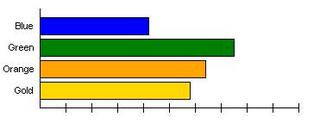 Of course, to understand WHO I AM, you’ve got to have access to the following analysis, which, if you look closely, you’ll recognize Maslow’s hierarchy at the levels of "Actualization" and "Esteem":
Of course, to understand WHO I AM, you’ve got to have access to the following analysis, which, if you look closely, you’ll recognize Maslow’s hierarchy at the levels of "Actualization" and "Esteem":
It turns out that Green is a great color to have; the company spared little effort in heaping praise on me. My need for ego stroking was amply fulfilled--so that (so far) I’ve given little thought to demanding a refund of my $22.50.
Green: Your Strength is Knowledge
If your brightest color is GREEN, you feel best about yourself when solving problems, especially when your ideas are recognized. You seek to express yourself through your ability to be an expert in everything, and your idea of a great day is to use your know-how to create solutions. You are a complex individualist with great analytical ability. Although you do not express your emotions openly, you do experience deep feelings. Greens are Happiest when Using Ingenuity
Those with GREEN as their brightest color have curious minds, exploring every facet of a problem or idea to control the realities of life. Global by nature, and always seeking universal truth, they acquire skills to perfect and product or system on which they choose to focus. They are symbolized by the abstract thinker, the unknown challenge of outer space, the complexity and simplicity of design, and the symmetry of forms.
With GREEN as Your Brightest Color, You Tend to . . .
· Dream of truth, perfection, and accuracy
· Value answers, resolutions, intelligence, and explanations
· Regard efficiency, increased output, and reduced waste
· Dislike injustice and unfairness
· Express coolness, calm and collected reservation
· Foster inventions and technology
· Respect knowledge and capability
· Promote effectiveness, competence, and know-how
Analytical self-assessment: Now that I know I possess all these characteristics, I'm wondering what went wrong in my life? Will I now have to deal with a tendency not to plunge into despair and permanent depression, knowing that I evidently somehow failed to achieve the greatness I was obviously destined for?
Note: The above summary evaluation doesn't include an in-depth explanation for the orange, gold, and blue components shown in the graph. At first this was a bit disquieting, because it occurred to me that these colors, in close combination with green, might reveal such a negative result, that the company daren’t publish it (except, of course, for another $22.50 and a confidentiality agreement). But to be fair, I suspect the complete analysis lies somewhere in one of the boiler-plate PDF file formats they sent me and which I haven’t perused yet—I'm confident the company wouldn’t risk shortchanging me with $22.50 at stake!
Ah, the never ending efforts of the “mind industry!” If you can’t get ‘em into the office and onto a couch, you can always sell 'em parlor games. Frankly, I’m not as critical of them as this essay might suggest—I believe the “mind industry” is far less dangerous to humans (probably more productive and definitely cheaper) by peddling their parlor games than they are with the patients whom they manage to get into their offices and onto a couch.
Post Script: If you want to save $22.50 for this latest twist on pop psychology, e-mail me and I’ll send you the 24 questions (never mind what the "answers" are, because there are no right or wrong answers) as well as copies of the downloads for nothing--it's exactly the same material you'd get if you were to invest your own $22.50. Then referring to this material, select the color that seems to fit you best and simply arrange your chart that will result in the most complimentary outcome--after all, the fact that you're interested in knowing WHO YOU ARE automatically puts you into the top categories of the "self-actualization" triangle. Anyway, that's about all the online company would do for your $22.50. (Note: I withdraw this offer if I later discover that the material is clearly and specifically copyrighted--the company might mistake me for a big-time writer with deep pockets and go after me in a frivolous lawsuit.)
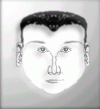
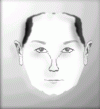
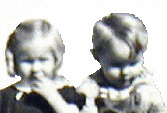
No comments:
Post a Comment